Setting out on a remote wilderness hike in the Scottish Highlands is an invigorating challenge. The undulating terrains, often blanketed in mist, offer breathtaking views and encounters with wildlife like the majestic red deer. The weather is notoriously capricious; expect four seasons in a day. Proper preparation is critical, necessitating layered clothing, waterproof gear, and sturdy hiking boots with reliable grip. Navigation tools such as a map and compass are indispensable for traversing unmarked trails. Planning includes securing accommodations and understanding cash requirements in remote areas. Experience the essence of Highlands exploration by preparing thoroughly for a truly rewarding adventure.
Key Takeaways
- Essential navigation tools include a physical map and compass, as GPS may fail in remote Highland terrain.
- Layered clothing and waterproof boots are crucial for adapting to unpredictable Scottish weather conditions.
- Cash management is vital due to limited ATMs and the potential for cash-only transactions in remote areas.
- Inform trusted contacts about your planned routes and return times to enhance safety during hikes.
- Joining guided adventures provides expert navigation, safety tips, and local insights for enriching hiking experiences.
Understanding Scottish Weather
Maneuvering the capricious nature of Scottish weather is a fundamental aspect of any hiking adventure in the Highlands. The region is known for its unpredictable weather patterns and climate variations, with no month reliably offering dry conditions. Hikers must be prepared for all scenarios, as temperatures and precipitation can shift dramatically even within a single day. Essential gear includes layered clothing and waterproof equipment to adapt to sudden changes.
Springtime, from April to June, brings a transformation as wildflowers bloom and hillsides shift from brown to verdant green, offering a picturesque backdrop for exploration.
Summer months, July and August, are marked by lush greenery and the iconic purple heather, painting the landscape in vibrant hues. However, these months can also bring unexpected rain showers, underscoring the importance of preparation.
Autumn, particularly around mid-October, enchants with its peak colors, offering breathtaking vistas as the foliage turns. The unpredictable weather, however, poses challenges, especially at higher altitudes where rain and snow can impact visibility and trail conditions.
Checking weather forecasts becomes imperative to guarantee safety and maximize the experience of hiking amidst the dramatic and ever-changing beauty of the Highlands.
Exploring the Highlands
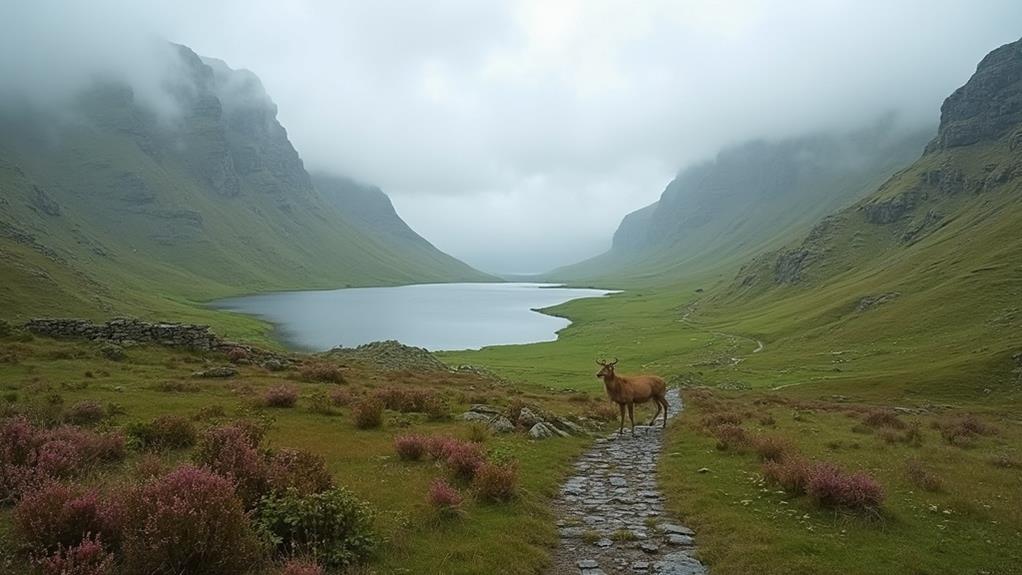
As hikers prepare for the unpredictable Scottish weather, they set their sights on the awe-inspiring landscapes that the Highlands have to offer. The region's raw beauty is unmatched, with its rugged terrains, stunning mountain ranges, and numerous rivers creating a paradise for those seeking adventure.
The West Highlands, North West Highlands, and the Cairngorms are key destinations, each showcasing diverse landscapes and unique geological formations. These areas are a demonstration to the Highlands' wild and untouched nature, with Ruadh Stac Mor standing as the furthest point from a road on mainland Britain.
The historic trails of the Highlands, such as the West Highland Way and the Lairig Ghru, provide a gateway to breathtaking scenery. The West Highland Way, stretching 154 km from Milngavie to Fort William, is a favorite among hikers, offering a journey through some of the region's most iconic landscapes.
Along these trails, one can encounter the rich Highland flora, which adds a vibrant tapestry of color to the scenery.
Wildlife thrives in this remote wilderness, with red deer often spotted amidst the heathered hills, providing a glimpse into the untouched ecosystem where nature reigns supreme.
Navigating Hiking Trails
Maneuvering the hiking trails of the Scottish Highlands requires a keen awareness of trail safety essentials and a proactive approach to weather preparedness.
With many routes lacking official signposts, hikers must rely on map and compass skills to traverse both gentle paths and challenging terrains.
Equipping oneself with reliable navigation tools and staying informed about the rapidly changing weather conditions are essential steps to guarantee a safe and enjoyable hiking experience in this majestic landscape.
Trail Safety Essentials
Venturing into the remote wilderness of the Scottish Highlands demands meticulous preparation and a keen awareness of trail safety essentials. This rugged terrain, with its breathtaking vistas, can present unexpected trail hazards that require hikers to be well-equipped and vigilant.
The first step in guaranteeing safety is to carry a physical map and compass. GPS signals can be unreliable, and visibility might change drastically, making these traditional wayfinding tools indispensable. Understanding the trail's distance and elevation prepares you for its physical challenges, reducing the risk of exhaustion-related mishaps.
Communication is pivotal when traversing isolated regions. Always inform a trusted person of your planned route and expected return time; this simple yet vital step can expedite rescue efforts if an emergency arises.
Equipped with essential gear like a first aid kit, flashlight, and extra sustenance, you'll be better prepared to handle unforeseen situations.
- Carry a physical map and compass: GPS can falter; traditional tools guarantee navigation.
- Communicate your plans: Inform someone of your route and return time for safety.
- Prepare essential gear: First aid kit, flashlight, extra food, and water are vital.
Embrace these protocols to enjoy the Highlands' beauty safely.
Weather Preparedness Tips
Weather in the Scottish Highlands can be capricious, often transforming a seemingly pleasant day into a challenging ordeal. To adequately prepare for such unpredictability, frequent checks of weather forecasts are essential. The Highlands are notorious for sudden changes, with rain and snow possible, especially at higher altitudes. Appropriate weather gear is vital; a lightweight waterproof jacket is indispensable for staying dry, while sturdy walking boots provide necessary stability on rugged terrain.
Layered clothing is key for effective temperature management, allowing hikers to adjust to the variable conditions. A moisture-wicking base layer helps keep perspiration at bay, an insulating middle layer retains body heat, and a waterproof outer layer protects against the elements. This combination guarantees comfort and adaptability as temperatures fluctuate.
Understanding local weather patterns and potential hazards is significant. In summer, midges can be a nuisance, whereas winter brings risks of freezing temperatures. These factors necessitate carrying extra food and water, securing sustenance throughout the hike.
Moreover, adverse weather can drastically reduce visibility, making it essential to familiarize oneself with the terrain beforehand. Although navigation tools are paramount, thorough preparation can make all the difference in safely traversing the remote trails.
Navigation Tools Guide
As hikers gear up to explore the vast and unpredictable landscapes of the Scottish Highlands, mastering the art of navigation becomes as important as preparing for the region's volatile weather.
Navigational aids are indispensable in this remote wilderness, with a reliable map and compass forming the cornerstone of any navigation toolkit. These tools, unaffected by battery depletion or signal loss, guarantee that adventurers can always find their way. Developing compass skills is essential, allowing hikers to orient themselves and cross even the most unmarked terrain with confidence.
While GPS devices and smartphone apps can greatly enhance navigation, they should never replace traditional methods. Technical failures or poor reception are common in these rugged landscapes, making a physical map an essential backup.
Familiarity with the Scottish Outdoor Access Code is also critical, offering important guidelines for responsible navigation and land use.
To visualize the fundamental navigational elements:
- Reliable map and compass: Your steadfast companions, guiding you through the unknown.
- Smartphone apps and GPS: Supplements to your toolkit, providing additional layers of information.
- Guide services: For those less confident, expert guidance assures safety and peace of mind in challenging terrains.
Regularly checking your route and surroundings further guarantees a successful journey through the Highlands' breathtaking wilderness.
Essential Clothing and Gear
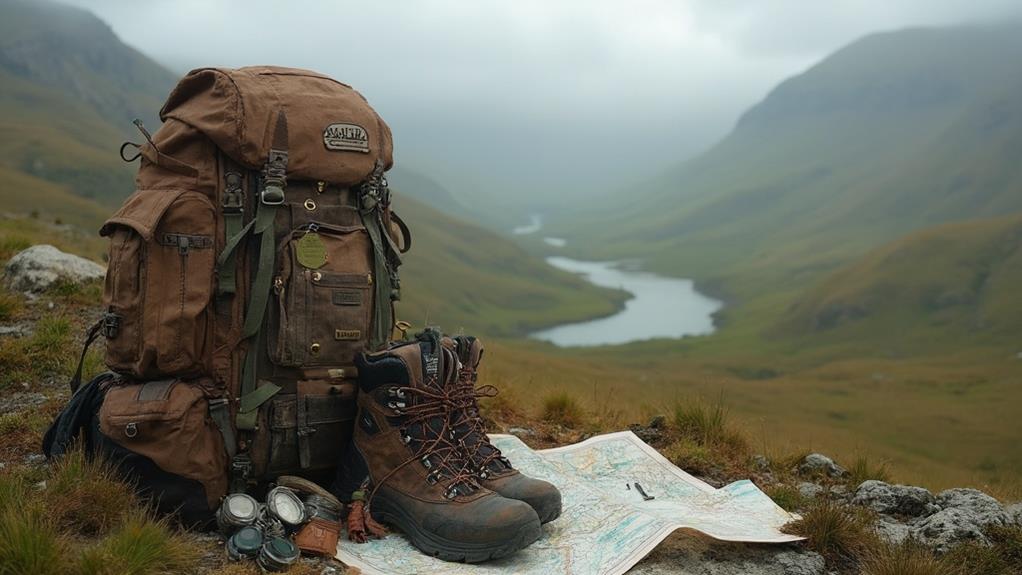
Initiating a remote wilderness hike in the Scottish Highlands demands careful attention to clothing and gear, with layered clothing being essential to adapt to the region's famously unpredictable weather.
Equally important are sturdy, waterproof walking boots, which provide the necessary support and protection on the rugged and often wet terrains.
Together, these essentials not only enhance comfort but also play a fundamental role in ensuring a safe and enjoyable hiking experience amidst the Highlands' breathtaking landscapes.
Layered Clothing Importance
The Scottish Highlands' unpredictable weather demands a well-thought-out approach to clothing, where the art of layering becomes indispensable for any wilderness hike. Mastering layering techniques is essential to adapt to the region's rapidly changing conditions. By selecting appropriate clothing materials, hikers can maintain comfort and safety throughout their journey.
Begin with a base layer crafted from moisture-wicking fabrics to guarantee skin remains dry, even during strenuous activity. This is followed by an insulating layer, such as fleece, which offers warmth without unnecessary bulk. The crowning piece of this ensemble is the outer layer: a waterproof and windproof jacket and trousers designed to shield against the Highlands' notorious rain and gusty winds.
- Moisture-wicking base layer: Keeps skin dry and comfortable by drawing sweat away.
- Fleece insulating layer: Provides warmth without restricting movement, essential for colder temperatures.
- Waterproof and windproof outer layer: Protects against rain and harsh winds, a staple for Highland hikes.
Furthermore, incorporating thermal clothing is advisable for chillier conditions, while an extra layer can be donned during rest breaks or at higher altitudes. This strategic approach not only enhances comfort and mobility but also mitigates the risk of hypothermia, guaranteeing a safer hiking experience.
Waterproof Footwear Necessity
Traversing the trails of the Scottish Highlands demands a steadfast focus on gear, with waterproof footwear emerging as a non-negotiable necessity. The region's unpredictable weather patterns can transform trails into challenging, muddy expanses, and without appropriate waterproof walking boots, hikers are at risk of discomfort and potential injury.
The rugged terrain of the Highlands, featuring trails like the West Highland Way with frequent river crossings and slippery sections, underscores the importance of footwear styles designed for stability and protection. Sturdy, waterproof boots are essential not only for keeping feet dry but also for providing vital ankle support and grip, reducing the likelihood of slips on uneven paths.
The ideal pair should incorporate breathable materials to enhance comfort and minimize moisture buildup during extended hikes. However, investing in quality boots is only part of the equation; boot maintenance is equally important. Regular cleaning and conditioning help maintain the waterproof capabilities and longevity of the footwear.
Additionally, breaking in your boots before initiating extensive hikes is essential. This practice guarantees the boots mold comfortably to your feet, thereby minimizing the risk of blisters and enhancing your overall hiking experience in the unpredictable Highlands.
Planning Your Self-Guided Tour
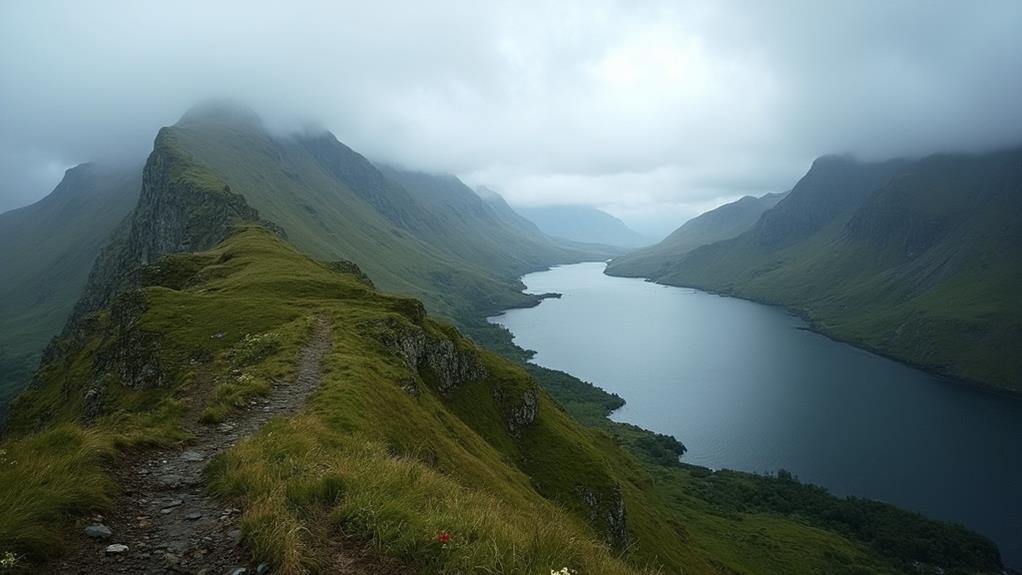
Planning a self-guided tour through the majestic Scottish Highlands requires meticulous preparation and a keen understanding of the terrain. Securing accommodation options well in advance is vital, particularly during peak hiking seasons. Booking 4-8 weeks ahead guarantees a comfortable stay along popular routes, allowing you to focus on the adventure ahead.
Understanding trail logistics is equally important. Explore resources like Walk Highlands to comprehend distances, elevation changes, and potential hazards. This knowledge equips you to navigate the rugged landscapes safely and enhances your overall experience.
Preparation is key when starting this wilderness journey. Pack with the unpredictable Scottish weather in mind, making sure you have layered clothing and sturdy, waterproof boots. Essential equipment, such as a map, compass, and first aid kit, should never be overlooked.
- Book accommodations early: Secure your stay along popular hiking routes.
- Study trail logistics: Familiarize with distances and elevation changes.
- Pack essential gear: Layered clothing, waterproof boots, map, compass.
Consider joining local hiking clubs or communities for shared experiences and insights into the trails.
Payment Options in Remote Areas
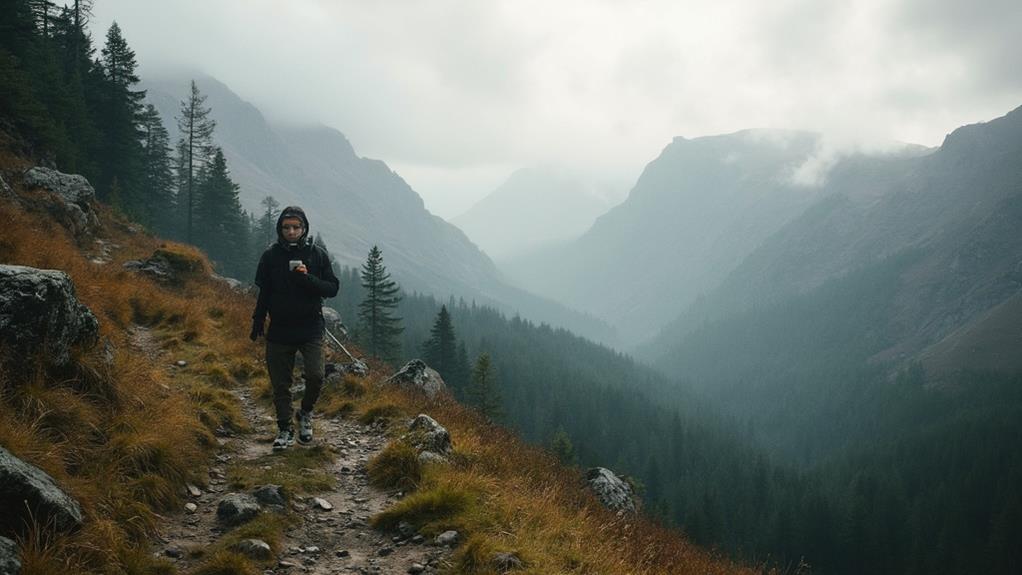
Maneuvering the financial landscape of the remote Scottish Highlands requires careful consideration and strategic preparation to secure a seamless hiking experience. While credit cards are widely accepted, relying solely on plastic can be a misstep in the more isolated areas.
Cash management becomes essential as some local stores and accommodations may only transact in cash. Consequently, carrying sufficient currency is advisable, especially since ATMs are scarce in these rugged regions.
When planning your adventure, investigate the payment options available in advance. This foresight guarantees that you can meet any necessary purchases or expenses during your hike.
Though credit card considerations are vital for larger transactions, such as booking guided tours or lodging, these often require pre-booking and might necessitate deposits via credit card.
In contrast, cash proves invaluable for smaller, everyday transactions. Whether it's purchasing snacks, enjoying a local craft, or tipping a guide, having the right amount of cash at hand can make a significant difference.
Ultimately, a balanced approach that combines both cash and credit card planning will cater to a diverse range of financial situations encountered in the remote and enchanting Scottish Highlands.
Communication and Safety Tips
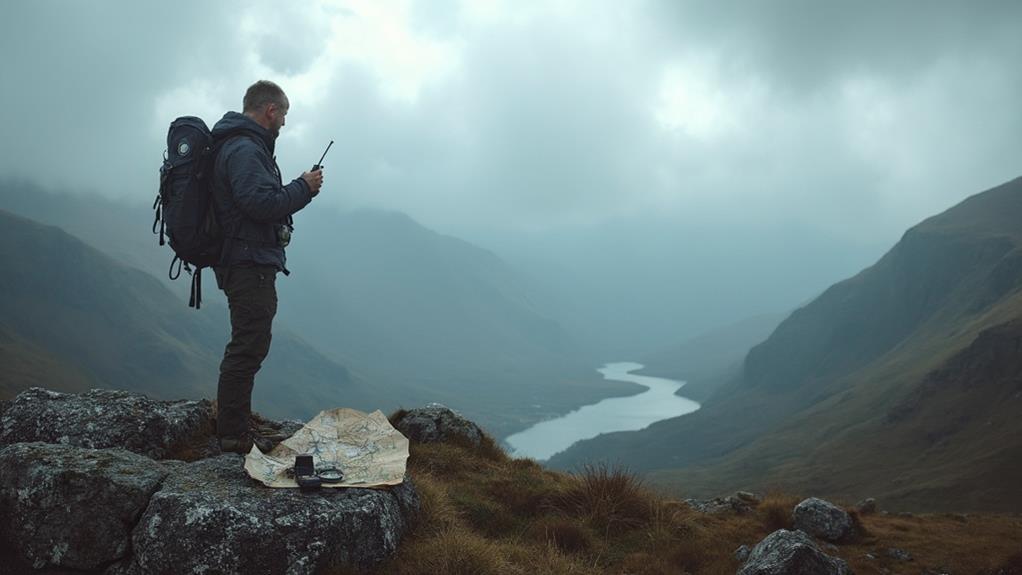
When starting on a hiking adventure in the Scottish Highlands, ensuring reliable communication is vital, especially in remote areas where cell service can be sporadic.
Equipping yourself with a 2-way satellite communication device offers a dependable link to the outside world, important for emergency situations.
Additionally, carrying a physical map and compass as part of your navigation toolkit is essential, as GPS devices may falter amidst the rugged terrain, ensuring you remain on course and safe.
Ensuring Reliable Connectivity
Steering through the breathtaking yet challenging landscapes of the Scottish Highlands requires thoughtful preparation, especially when it comes to maintaining reliable connectivity.
While cell phone coverage has been improving, the remote expanses of the Highlands can still present black spots where signals vanish, making it vital to have contingency plans. Utilizing 2-way satellite communication devices on your journey offers a dependable line of contact, even in the most isolated areas. Such devices are especially invaluable for guided trips, guaranteeing that emergency protocols can be enacted swiftly if needed.
To further secure your adventure, it is essential to inform a trusted contact of your travel plans and anticipated return times. This precaution enhances safety, allowing for prompt action in emergencies.
To keep communication devices powered during long hikes lasting 6-8 hours, carrying a portable charger is indispensable.
- Satellite Communication Devices: Guarantee connectivity in remote areas.
- Inform Trusted Contacts: Share travel plans and return times.
- Portable Chargers: Keep devices powered for longer hikes.
Additionally, familiarizing yourself with emergency contact numbers and the locations of the nearest help, along with basic first aid, can notably bolster your safety while exploring these majestic highlands.
Navigating Remote Areas Safely
Setting out on a journey through the remote areas of the Scottish Highlands requires more than just a spirit of adventure; it demands careful attention to communication and safety tips. In these vast, untamed landscapes, cell phone coverage can be unreliable, making it imperative to equip yourself with a two-way satellite communication device for emergency preparedness. This guarantees that help is just a message away, even in the most isolated regions.
Informing someone of your hiking plans, including your route and expected return time, is a significant step in guaranteeing your safety; this allows for swift location and assistance if circumstances go awry.
As you traverse these wild terrains, carrying a physical map and compass remains essential, as GPS devices may falter due to limited signal strength. Familiarize yourself with local emergency contact numbers and the locations of nearby help points along your path, fostering a sense of security amid the wilderness.
Additionally, wildlife awareness is paramount; encountering animals or sudden weather changes can pose significant risks. Being prepared for these eventualities not only enhances your safety but also enriches your experience, allowing you to fully embrace the breathtaking beauty of the Highlands with confidence and peace of mind.
Accessing Hiking Supplies
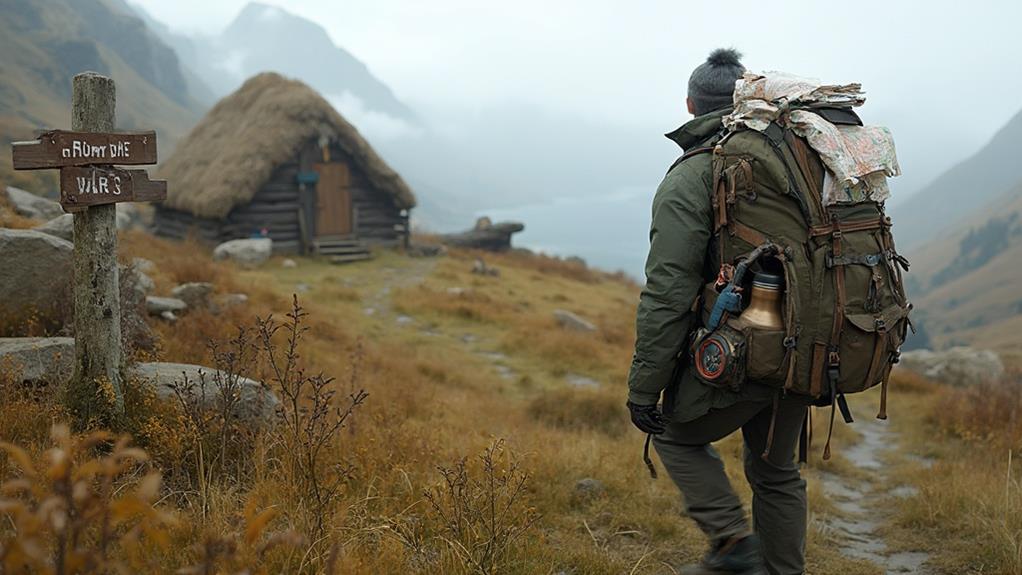
Accessing hiking supplies in the Scottish Highlands requires thoughtful preparation, as the region's remote wilderness offers limited opportunities for last-minute purchases. To guarantee a successful adventure, hikers should consider procuring their hiking gear well in advance.
Cities and Highland towns boast outdoor stores that provide an extensive range of essentials, from durable walking boots to waterproof clothing. These retailers not only stock necessary gear like insect repellent and sunscreen, but also offer expert advice on trail conditions, enhancing your hiking experience.
Local outfitters in more isolated areas present an invaluable resource for those seeking to lighten their load. They often provide rental options for critical hiking equipment, catering to the needs of minimalist adventurers.
However, the scarcity of facilities in these remote locations underscores the importance of purchasing supplies ahead of time, particularly as access to cash transactions may be limited.
Consider the following essential items to prepare for the unpredictable Highlands terrain:
- Quality walking boots for protection and support
- Waterproof gear to withstand sudden weather changes
- Navigation tools such as maps and compasses for safe exploration
Joining Guided Adventures
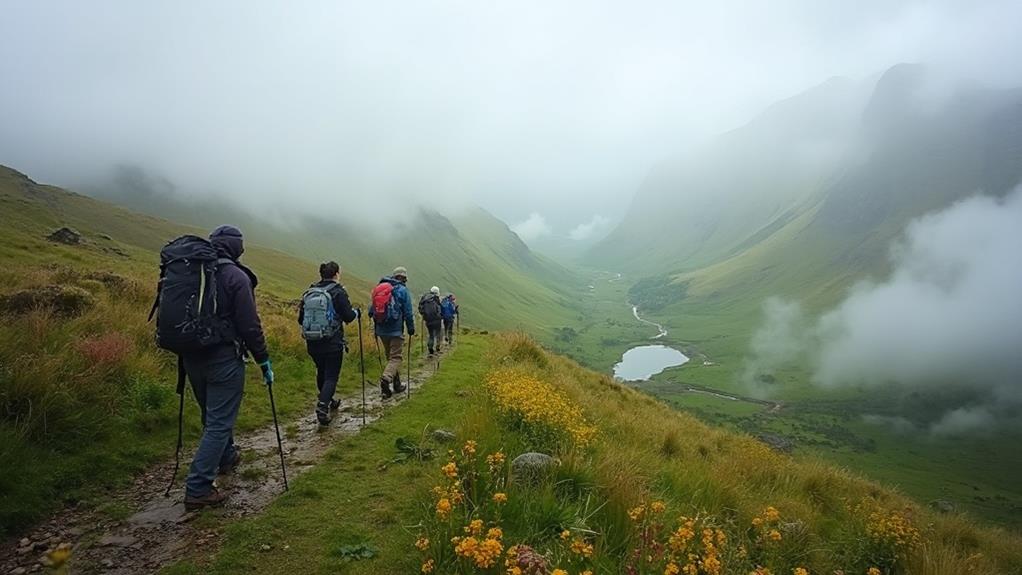
Exploring the remote wilderness of the Scottish Highlands can be an exhilarating endeavor, and joining guided adventures offers a structured and insightful way to navigate the region's rugged landscapes.
The benefits of guided adventures are particularly pronounced in areas where trails lack signposts and handrails, such as the Fisherfield Wilderness. Expert guides provide essential navigation tips, ensuring hikers safely traverse these challenging terrains.
Guided trips are tailored to accommodate a range of skill levels, allowing participants to enjoy the awe-inspiring beauty of Scotland's diverse landscapes without compromising safety.
Whether it's the thrilling ascents of the Cuillin Ridge or the scenic paths of the West Highland Way, experienced leaders enhance each journey with their local insights and safety expertise, vital in the unpredictable weather conditions of the Highlands.
Additionally, many guided tours emphasize small group sizes, promoting camaraderie and offering personalized experiences that resonate with participants.
These intimate settings allow for a deeper connection to the environment and fellow adventurers, enriching the hiking experience.
Seasonal variations in guided adventures reveal Scotland's changing scenery, providing unique opportunities to witness the Highlands' dynamic natural beauty under the guidance of knowledgeable experts.
Insights From the Author
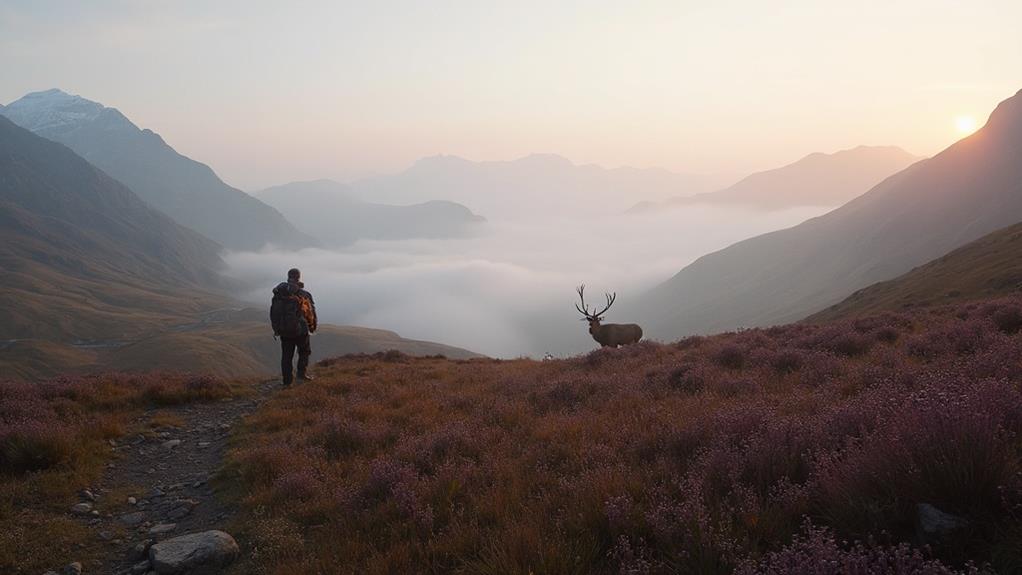
Wisdom gleaned from the seasoned trails of the Scottish Highlands underscores the insights shared by David Russell, an accomplished outdoor instructor.
Russell, with a wealth of experience, emphasizes meticulous preparation and adept navigation skills, pivotal for those daring to explore Scotland's remote wilderness. His reflections explore the wilderness transformation, where the mystique of these hikes transcends the mere physical journey, fostering a deeper appreciation for the path itself.
By advocating for the guidance of seasoned experts, he underscores the necessity of safety and enriched experiences in challenging terrains. His commitment to responsible hiking practices is unwavering, encouraging adherence to the Scottish Outdoor Access Code as a means of preserving the pristine natural habitats.
This dedication extends beyond mere conservation, as Russell's efforts champion youth empowerment through wilderness experiences. By guiding underprivileged youth into the Highlands, he nurtures personal growth and resilience, illustrating the profound impact of nature on human development.
- Picture the rugged terrain, where each step reveals a tapestry of untouched beauty.
- Envision the empowering journey of youth as they conquer the challenges of the wilderness.
- Imagine the unity between hiker and nature, a silent pact of mutual respect and preservation.
Recommended Further Reading
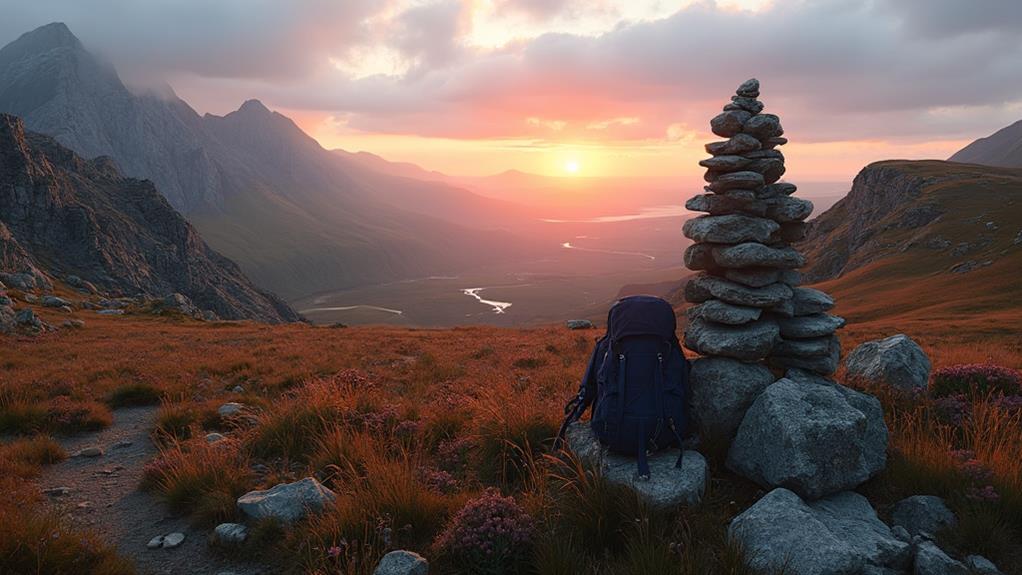
For those captivated by the allure of the Scottish Highlands, delving into the wealth of resources available can greatly enhance your hiking experience. Whether you're a seasoned trekker or a novice enthusiastic to explore, the following resources provide essential insights into hiking etiquette and trail conservation, guaranteeing your adventures are both enjoyable and environmentally responsible.
David Russell's articles spotlight the beauty and challenges of the Highlands, offering recommended routes near Aviemore. Monthly newsletters from hiking organizations foster community engagement by sharing updates on trips and seasonal highlights. Walk Highlands is an invaluable resource, offering detailed trail information, difficulty levels, and safety considerations for planning your excursions.
The Scottish Outdoor Access Code is a must-read, guiding you on responsible hiking practices to minimize environmental impact. Additionally, guides and local clubs provide indispensable knowledge, especially for newcomers to the area.
Here is a curated list of recommended further readings:
| Resource | Focus Area | Highlights |
|---|---|---|
| David Russell's Articles | Hillwalking Insights | Recommended routes near Aviemore |
| Walk Highlands | Trail Information | Route difficulty and safety tips |
| Scottish Outdoor Access Code | Responsible Hiking Practices | Environmental impact and hiking etiquette |
| Monthly Newsletters | Community Engagement | Trips, activities, and seasonal highlights |
| Guides and Local Clubs | Local Knowledge | Support for new hikers in remote areas |
Exploring these resources will guarantee a rewarding and conscientious hiking journey through Scotland's remote wilderness.
Frequently Asked Questions
What Is the Most Remote Part of the Scottish Highlands?
The most remote part of the Scottish Highlands is the Fisherfield Wilderness. With challenging navigation due to rugged terrain, hikers can anticipate wildlife encounters amidst its isolated peaks and rivers, requiring preparation for complex routes and diverse ecosystems.
What Is the Hardest Hiking Trail in Scotland?
The Cuillin Ridge on the Isle of Skye is renowned for its hiking difficulty and trail safety challenges. Spanning 12 miles, this strenuous trail demands advanced climbing skills and caution due to steep terrain and unpredictable weather conditions.
What Is the Isolated Shelter in the Scottish Wilderness?
The isolated shelter, known as Carnmore Estate, is a former gamekeeper's home offering basic wilderness shelter types. Essential for wilderness safety, it provides refuge within the rugged Fisherfield Wilderness, enhancing hikers' experiences amidst the remote Scottish landscape.
Are the Scottish Highlands a Wilderness?
The Scottish Highlands epitomize wilderness, defined by their rugged terrain, sparse human habitation, and abundant wildlife. Highlands ecology showcases diverse ecosystems and unpredictable weather, contributing to a formidable yet enchanting natural landscape, inviting exploration and demanding respect from adventurers.
Conclusion
In summary, remote wilderness hikes in the Scottish Highlands offer an unparalleled exploration of rugged landscapes, demanding a thorough understanding of the region's unpredictable weather and diverse trails. Proper preparation, including selecting essential clothing and gear, is vital for a successful journey. Whether opting for a self-guided tour or joining a guided adventure, the experience promises both challenge and reward. Accessing local hiking supplies further enhances the endeavor, ensuring hikers are well-equipped to navigate the awe-inspiring beauty of the Highlands.